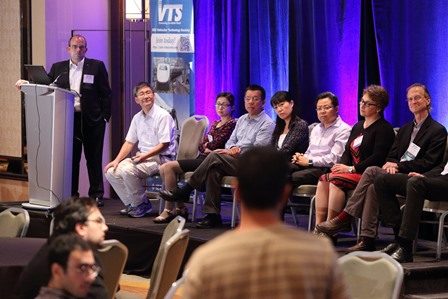The IEEE Young Professionals Montreal section and the IEEE Vehicular Technology conference hosted an event on PUBLISHING TOOLS AND TIPS FOR YOUNG PROFESSIONALS. The event took place in the exquisite Westmont ballroom in renowned Bonaventure hotel on 20th of September. Prof. Fabrice Labeau , the chair of the IEEE Montreal section and the professor of the Department of Electrical and Computer Engineering, McGill University welcomed participants and outlined the agenda of the event. Prof. Labeau introduced the keynote speaker of the event; Prof. Micheal Fang (Department of Electrical and Computer Engineering at University of Florida) the Editor-in-Chief of IEEE Transactions on Vehicular Technology. The presentation proved quite informative citing IEEE top journals and their impact factor, popularity score and narrowed down to VTS group’s average journal submission time for publication and review. Prof. Fang highlighted the monotonically increasing trend for eigen factor, article influence score on an annual basis, indicating the growing indispensable impact that this journal has and will have in the scientific community. Further indication of the journal’s popularity was conferred by the increase in the annual downloads and number of submissions.
160920-180036-23987
Want to publish in IEEE journals, what are the steps and considerations?
Prof. Fang discussed pertinent topics of selection of a research area, and importance of the contribution in acceptance of the paper. Contribution was defined as either presenting a new method or algorithm to solve a problem or applying an existing algorithm on new applications. The pros and cons of submitting and publishing in journals vs conferences were presented. To increase the chance of acceptance of a paper, it is important that the scope of the selected journal/conference be highly relevant to the content and work in the paper. It also helps to be aware of the journal readership and the nature of the papers published in that specific journal/conference. Each journal has a unique writing style, structure, method of addressing problems and stating the contributions. It is therefore crucial that a submitted paper should fit into that specific culture and format. This discussion was followed by a short summary of the review process leading to the final decision on the acceptance, with minor/major revision or rejection. Editors/reviewers primarily look for technical soundness, fewer grammatical errors, good illustrations and updated reference to make their decisions. One of the early stages in reviewing a submitted paper is to use software packages which search for the patterns of similarity between the submitted paper and other published work. If the software finds major similarities such as same graphs, text matching then it will be flagged for plagiarism. If this confirmed it can result in disastrous consequences for the authors including banning the author/s from submitting of his/her work for several years. This can have significant impact on the career of the author, in particular if they undertaking graduate studies and are required to publish in order to graduate. Authors should also avoid major similarities between their submission and their own published work as it is also unacceptable, referred to as self-plagiarism.
The presentation also discussed the reasons for rejection and content of a good paper, stressing the importance of selecting of a good title. Guidelines were also provided on specific sections of a paper i.e. abstract, keywords, introduction and choice of tense (preferably passive). The methodology section should summarize and present illustrative graphs and tables of the data to support the contributions of the research. Results should be interpreted and the benefits and shortcomings of the research should be presented. Authors must cite all relevant work and credit authors with due diligence who have previously made contributions in this area.
160920-191026-17179
Professor Fang then moved on to provide general advice on the review process. He stressed the importance of not rushing with replies to the final decision and of course warned that a negative response could prove detrimental. A polite response is desired by all means and a reviewer’s comments should be addressed in detail point by point with clear evidence and data. The ethics of a reviewer have also been discussed, as one should carefully ascertain whether the research topic falls within the reviewer’s domain of expertise. Furthermore, the reviewer is expected to read the submitted work carefully, putting in the desired amount of time and providing constructive and comprehensive comments. Prof. Fang encouraged the audience to become reviewers by getting involved in conference committees. He emphasized that in the case that reviewers do a good job in reviewing the papers, they can ask for the recommendation of editors for being reviewers of the high rank journals. Prof. Fang mentioned that the information in his presentation is all available on the IEEE website and encouraged everyone to utilise the tools available for authors.
The Panel
After the presentation, a panel of experienced authors/reviewers and editor in chief’s was formed for a discussion session. The panellist consisted of:
Gerhard Bauch, Area Editor, IEEE Trans. on Vehicular Technology,
Vijay Bhargava from University of British Columbia and Past Editor-in-Chief, IEEE Trans. on Wireless Communications,
Octavia Dobre from Memorial Univeristy of Newfoundland and Editor-in-Chief, IEEE Communications Letters,
Rose Qingyang Hu from Utah State Univeristy and Editor, IEEE Trans. on Vehciular Technology,
Yi Qian , from University of Nebraska-Lincoln and Editor, IEEE Trans. on Vehciular Technology,
Xianbin Wang from Western University and Editor, IEEE Trans. on Vehciular Technology,
Alexander Wyglinski from Worcester Polytechnic Institute and Editor, IEEE Trans. Comm, IEEE Trans. Wirleess Comm, IEEE Comm. Mag,
Lian Zhao (Ryerson) Editor, IEEE Trans. on Vehciular Technology.
The panel was questioned by the audience and for each question, almost all the panellist presented their ideas and discussed the question from different point of views. Some of the interesting questions and an abstract of the answers by panellist are summarized below.
160920-191206-17188
Q1: Are analytical results or simulation results sufficient for publication, and are experimental results necessary to get the acceptance?
Generally a good paper should have all three elements of analysis, simulation and measurement. However, not having experiments and measurements does not result in rejection as long as the contribution is significant and has the support of analytics or simulation. For example, for the TVT/VTS journal, analytical result accompanied by the simulation for validation would be sufficient.
Q2: To extend a conference paper to journal paper how much modification is required? Is 30 % addition of new material mandatory?
Journal papers should have quality and hence a conference paper previously published without any improvement or significant contribution cannot serve as a journal paper. Generally one cannot publish the same content in journal and conference. This is considered as a repetitive work and it is not acceptable. However, the author may add modifications and new points to the former published contribution, which makes it acceptable to be published as a new paper considering a proper reference update. In terms of how much modification is needed, the policy is different for every journal but in VTS the 30% criteria is no longer present as it is hard to justify. The policy has changed to have significant difference.
Q3: How to validate the approximation used in a research and the paper?
First the performance of applying the approximation should be checked in simulation and later validate with experiment if given problem hiders closed form results.
Q4: Number of pages for a conference?
It should be crisp, convey an idea and contribution. Focus should be primarily on contribution rather than adding redundant information which serves no purpose.
Read more about author education
Earlier this year we focused on the importance of educating authors to be ethical in their approach to conducting research and essentials of author etiquette with Prof. Sheila Hemami.
https://yp.ieee.org/author-education-and-etiquette-with-prof-sheila-hemami-vp-ieee-pspb/
Article contributed by Masoumeh Esfandiari, Chair IEEE Young Professionals Montreal Section
Article edited by Eddie Custovic, Editor in Chief, IMPACT by IEEE Young Professionals






